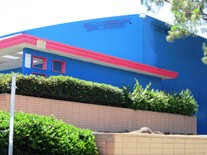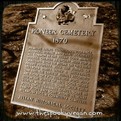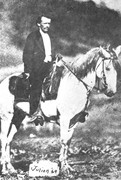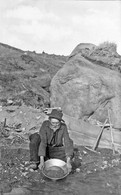
Will C. Crawford HS - Alumni Association & Foundation

Julian Area
Please enjoy these early photographs of the Julian area.
A Brief History:
Founded following the Civil War, the town of Julian was named by Drue Bailey after his cousin Mike Julian, who later was elected San Diego County Assessor. In 1869, A.E. "Fred" Coleman, a former slave, was crossing over what is now known as Coleman Creek, just west of Julian. Seeing a glint of gold in the stream bed, he climbed down from his horse to investigate. Having had previous experience in the gold fields, he retrieved his frying pan and began panning the sands of the creek. Soon thereafter Coleman established the Coleman Mining District and was its recorder and also began the mining camp called Emily City later renamed Coleman City. Learning of the find, others rushed to the district and tried to trace the gold to its source.
On February 22, 1870, the first "lode", or hard rock, mining claim was filed in the Julian area. Since February 22 was President George Washington's birthday, the mine was named the Washington mine. Soon hundreds of anxious men and families were rushing to Julian to stake their claims. Julian experienced a gold rush and became a tent city overnight. In April 1870, the area's first saw mill was set up and Julian began to take on a more permanent structure. Attempts to build rival mining towns at Coleman City, Branson City and Eastwood were defeated. Owners of the Cuyamaca Rancho Land Grant claimed (the Cuyamaca Land Float) Julian and its mines were within the Rancho boundaries. In 1873, the courts ruled that the Rancho did not include Julian and the mines.
While the miners were trying to wrestle the gold from deep within the earth, James Madison brought a wagon load of young apple trees up into the mountains. The fruit trees flourished in the clear, fresh air. Apples are still a big product in Julian, many of which are used for making the world-famous Julian apple pies.
According to a bronze historical plaque appearing in the town, in the early days of Julian, the majority of San Diego County's African-American population resided in or near the town, including the founders of the Robinson Hotel as well as a noted resident, America Newton. Of the 55 blacks living in San Diego County during the 1880 census, 33 lived in the Julian area. (Although this information appears on the plaque, it has been the subject of some controversy.)
In recent decades Julian has become a quaint mountain resort. The town narrowly escaped destruction in the 2003 Cedar Fire that burned much of the surrounding area.
Links:
" Life Beyond Gold: A New Look at the History of Julian, California" by Kathry A. Jordan. Source: A Journal of San Diego History. (pdf file)





















